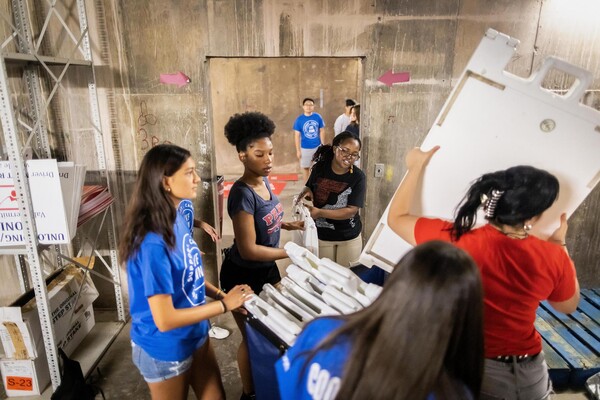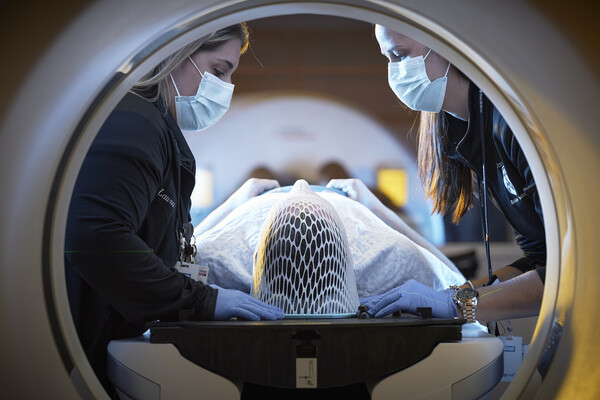Music to their ears...and eyes
Penn’s on-campus radio station, WXPN, has always had a loyal family of fans drawn to the stationís progressive blend of rock, folk, rhythm and blues and American roots. Since it began broadcasting in the 1940s, though, WXPN has operated out of the lowliest of digs, a series of retrofitted campus buildings more suitable for a fraternity than a major radio station.
Thatís all changed now that the ribbon has been cut on the stationís state-of-the-art new home in the Hajoca, a former plumbing supply showroom at 3025 Walnut Street. In an unusual partnership, WXPN is sharing space with a for-profit live music performance venue, World Café Live, operated by local entrepreneur Hal Real, founder of the Real Entertainment Group.
Hereís how it works: WXPN has one side of the building—with offices fronting Walnut Street atop a warren of sound studios and control rooms—while World CafÈ Live welcomes the public on the other side with a restaurant and a three-tier live performance hall. Separating the two operations—which operate independently, though WXPN sold Real Entertainment rights to the "World Café" moniker—is an imposing modern stair tower and a colorful mural by local artist Paul Santoleri.
The building retains its lofty, industrial feel, though it’s softened by earthy colors and funky patterns befitting the folksy feel of the radio station. The World Café Live venue adds a layer of well-upholstered luxury, making it a comfortable, grown-up venue for watching live music and diningósort of like dinner theater, only hipper. Bands taping sessions for David Dye’s World Café will surely be grateful for the relatively palatial new 1,000 square foot studio, whose glass walls also give passers by a glimpse of the musical action. It certainly beats the tiny studio on Spruce Street, where, as the oft-told story goes, part of Lyle Lovett’s Large Band ended up performing in the hallway.
None of this happened, though, without a few teething pains. As Penn’s Senior Vice President for Real Estate and Facilities Omar Blaik says, "This was a project that was unwilling to take off." Penn had owned the abandoned Hajoca building for several years, and as the area around it was improvedóespecially with the spiffy Left Bank apartments and retail storesóit was beginning to look like an eyesore. Several proposals had been put forward for its use, including a bid by Philadelphia Magazine, but in the fall of 2001 it still stood forlorn and unoccupied.
Meanwhile, WXPN and World Café Live were in search of real estate. Several locations had been considered, and one idea—to use the Science Center on Market Street—had just fallen through when the radio stationís former general manager, Vinnie Curran, visited Blaik at his Left Bank office. "I literally was walking out of the building with him," recalls Blaik, "and as I was looking around me I said, 'Vinnie, what if we put you here...this is the future. It’s on Walnut, not Market, and it’s closer to Center City.'"
From that moment of epiphany, it took two more years for the deal to be sealed, which, says Director of Real Estate Development Paul Sehnert, isnít too surprising when you consider that it involved three architects, four consultants—including an acoustical consultant and a feng shui consultant—one developer (Carl Dranoff) and several investors, not to mention the slew of license agreements, tax credits, historic landmark easements and other paperwork that had to be resolved.
During the nine months of construction, it was Director of Development and Project Management Alex Handago who kept everything on time and within budget. Since WXPNís fundraising goals had been set before the Hajoca building came into the picture, funds were always tight. But, says Handago, "It was very good discipline, because if we couldnít pay for it, it couldnít happen. I think it made people very creative and led to better design solutions."
When it came to the exterior, though, all agreed it was worth digging deeper into their pockets for classy blue awnings and a neon sign visible from the Expressway. Carl Dranoff also took it upon himself to restore the metalwork over the original 1930s entrance.
For Blaik, the project puts another piece of the jigsaw puzzle in place. "Only three and a half years ago, we were sitting in a wasteland between Penn and Center City. The Hajoca was abandoned. Now, thereís live music next to a green space where kids play soccer, and thereís the housing and the retail." That, says Blaik, is what he wants to accomplish all over Penn. "So, when you come back...10 years from now, weíll be able to say what we created here was just the beginning."
Never mind 10 years from now—Handago and Sehnert are enjoying the present, and the fact that in the last week they’ve seen Aaron Neville up close and personal and, says Handago, "a guy playing a guitar on Walnut Street." Though he wasnít part of the radio station or World Café Live, she says, he came here to play because he knew this was a place where people come to hear music.








